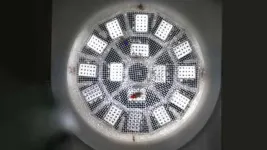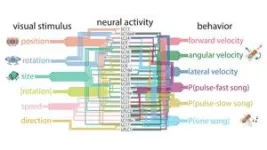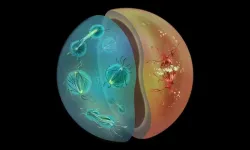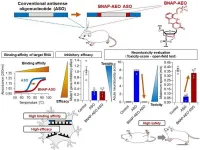(Press-News.org) We’ve been told, “The eyes are the window to the soul.” Well, windows work two ways. Our eyes are also our windows to the world. What we see and how we see it help determine how we move through the world. In other words, our vision helps guide our actions, including social behaviors. Now, a young Cold Spring Harbor Laboratory (CSHL) scientist has uncovered a major clue into how this works. He did it by building a special AI model of the common fruit fly brain.
CSHL Assistant Professor Benjamin Cowley and his team honed their AI model through a technique they developed called “knockout training.” First, they recorded a male fruit fly’s courtship behavior—chasing and singing to a female. Next, they genetically silenced specific types of visual neurons in the male fly and trained their AI to detect any changes in behavior. By repeating this process with many different visual neuron types, they were able to get the AI to accurately predict how the real fruit fly would act in response to any sight of the female.
“We can actually predict neural activity computationally and ask how specific neurons contribute to behavior,” Cowley says. “This is something we couldn’t do before.”
With their new AI, Cowley’s team discovered that the fruit fly brain uses a “population code” to process visual data. Instead of one neuron type linking each visual feature to one action, as previously assumed, many combinations of neurons were needed to sculpt behavior. A chart of these neural pathways looks like an incredibly complex subway map and will take years to decipher. Still, it gets us where we need to go. It enables Cowley’s AI to predict how a real-life fruit fly will behave when presented with visual stimuli.
Does this mean AI could someday predict human behavior? Not so fast. Fruit fly brains contain about 100,000 neurons. The human brain has almost 100 billion.
“This is what it’s like for the fruit fly. You can imagine what our visual system is like, " says Cowley, referring to the subway map.
Still, Cowley hopes his AI model will someday help us decode the computations underlying the human visual system.
“This is going to be decades of work. But if we can figure this out, we’re ahead of the game," says Cowley. "By learning [fly] computations, we can build a better artificial visual system. More importantly, we’re going to understand disorders of the visual system in much better detail.”
How much better? You’ll have to see it to believe it.
END
New AI accurately predicts fly behavior
2024-05-22
ELSE PRESS RELEASES FROM THIS DATE:
Study: Under extreme impacts, metals get stronger when heated
2024-05-22
Metals get softer when they are heated, which is how blacksmiths can form iron into complex shapes by heating it red hot. And anyone who compares a copper wire with a steel coat hanger will quickly discern that copper is much more pliable than steel.
But scientists at MIT have discovered that when metal is struck by an object moving at a super high velocity, the opposite happens: The hotter the metal, the stronger it is. Under those conditions, which put extreme stress on the metal, copper can actually be just ...
Firearm Homicide Demographics Before and After the COVID-19 Pandemic
2024-05-22
About The Study: In this study, death by firearm homicide was concentrated among Black individuals ages 15 to 24 before, during, and subsequent to the COVID-19 pandemic, implying that there are likely to be social and structural conditions that contribute to these racial disparities.
Corresponding Author: To contact the corresponding author, Alex R. Piquero, Ph.D., email axp1954@miami.edu.
To access the embargoed study: Visit our For The Media website at this link https://media.jamanetwork.com/
(doi:10.1001/jamanetworkopen.2024.12946)
Editor’s ...
Transmission of mental disorders in adolescent peer networks
2024-05-22
About The Study: The findings of this study suggest that mental disorders might be transmitted within adolescent peer networks. More research is required to elucidate the mechanisms underlying the possible transmission of mental disorders.
Corresponding Author: To contact the corresponding author, Jussi Alho, Ph.D., email jussi.alho@helsinki.fi.
To access the embargoed study: Visit our For The Media website at this link https://media.jamanetwork.com/
(10.1001/jamapsychiatry.2024.1126)
Editor’s Note: Please see the article ...
Transitioning gender identities is not linked with depression
2024-05-22
A landmark longitudinal study of LGBTQ+ youths has found that transitioning gender identities is not associated with depression and that about 1 in 3 gender-minority youths change their gender identity more than once. In fact, the study found higher rates of depression among transgender youths are more closely associated with bullying and victimization.
The findings from a team of researchers at The University of Texas at Austin and in Brazil are outlined in a paper in JAMA Network Open.
The study followed 366 LGBTQ+ young people ages 15-21 in two U.S. cities from 2011 to 2015 and measured depressive symptoms ...
Century-old vaccine protects type 1 diabetics from infectious diseases
2024-05-22
BOSTON--In new research, investigators at Massachusetts General Hospital (MGH) show that the 100-year-old Bacillus Calmette-Guérin (BCG) vaccine, originally developed to prevent tuberculosis, protects individuals with type 1 diabetes from severe COVID-19 disease and other infectious diseases.
Two back-to-back randomized double-blinded placebo-controlled trials found that the BCG vaccine provided continuous protection for nearly the entire COVID-19 pandemic in the US, regardless of the viral variant.
“Individuals with type 1 diabetes are highly susceptible to infectious diseases and had worse outcomes when they were infected with the SARS-CoV-2 virus,” ...
How and why different cell division strategies evolve
2024-05-22
Cell division is fundamental to life, enabling growth, reproduction, and survival across all organisms, from single-celled bacteria to complex multicellular animals. While animals and fungi share a common eukaryotic ancestry, their mechanisms of cell division, particularly mitosis, have diverged significantly, raising intriguing evolutionary questions.
Animals typically undergo open mitosis, where the nuclear envelope disassembles during cell division, while fungi exhibit closed mitosis, maintaining an intact nuclear envelope. The evolutionary reasons behind these divergent strategies ...
IPK research team uncovers mechanism for spikelet development in barley
2024-05-22
The inflorescence architecture of crop plants like barley is predominantly regulated by meristem activity and fate, which play a critical role in determining the number of floral structures for grain production. Spikelets are the basic reproductive unit of grass inflorescences. The identity and determinacy of many grass meristems are partially determined by a group of genes expressed specifically at organ boundaries, which can form local signalling centres that regulate adjacent meristem fate and activity.
These genes are critical for establishing and ...
Ancient DNA study reveals population history of Western Tibetan Plateau
2024-05-22
According to a study published in Current Biology on May 22, the genetic components of the ancient populations in the western Tibetan Plateau are closest to ancient populations in the southern Tibetan Plateau, and their major genetic components have been maintained over the past 3,500 years. In addition, these ancient populations in the western Tibetan Plateau had complex and frequent interactions with ancient populations inside and outside the plateau.
The study was conducted by Prof. FU Qiaomei's team from the Institute of Vertebrate Paleontology and Paleoanthropology ...
Exploring diversity in cell division
2024-05-22
Cell division is one of the most fundamental processes of life. From bacteria to blue whales, every living being on Earth relies on cell division for growth, reproduction, and species survival. Yet, there is remarkable diversity in the way different organisms carry out this universal process. A new study from EMBL Heidelberg’s Dey group and their collaborators, recently published in Nature, explores how different modes of cell division evolved in close relatives of fungi and animals, demonstrating, for the first time, the link between an organism’s ...
Sweet move: a modified sugar enhances antisense oligonucleotide safety and efficacy
2024-05-22
Researchers from Tokyo Medical and Dental University (TMDU) and Osaka University find that a newly developed modified sugar increases the efficacy and safety of antisense oligonucleotides designed to treat central nervous system disease
Tokyo, Japan – Diseases that affect the brain and spinal cord can be particularly devastating, and finding new and more effective ways to treat these conditions is an important goal for researchers and clinicians alike. Now, a research group from Japan reports that slightly modifying an existing treatment for central nervous system (CNS) disease dramatically increases its ...





